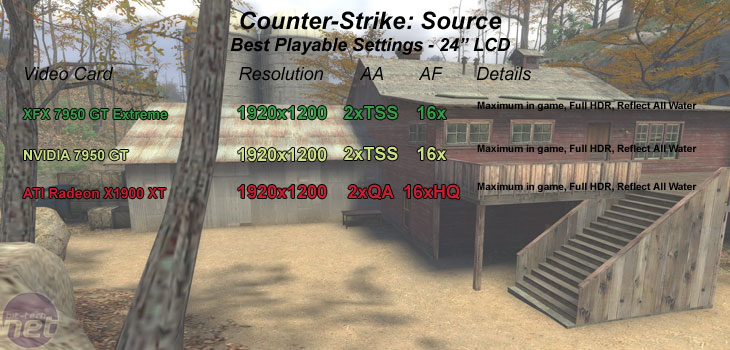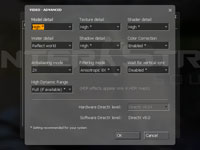For gameplay evaluations on a CRT, please head back to our CRT performance section.
Counter-Strike: Source is one of the most widely played online titles in the world at the moment, making it an excellent test of mid-range hardware capability. Several levels (including Train, Militia, and Nuke) feature Valve's interpretation of high-dynamic range rendering. We used the most recent version of the game, and did three five minute portions of real world game play on the Militia map. We created a server on our internal network with 15 bots hosted on a different machine on the network.
Anti-aliasing and anisotropic filtering were controlled from inside the game, and thus the drivers were left set to "Application Controlled". There are three options for the method of HDR used in this title. You can either disable HDR completely, make use of "Bloom" which is just what it says and less resource hungry in comparison to "Full" which, again is just what it says. It utilises a full dynamic range with the iris effect too.
We have written quite a bit about Half-Life 2: Lost Coast, Day of Defeat: Source, Episode One and how Valve have implemented HDR in to the Source Engine. You can check out the articles listed below for more information on The Lost Coast & Day of Defeat: Source.
Militia is probably the most stressful map in the game and it serves well as a worst-case scenario for testing purposes. Thankfully though, the game runs superbly on a wide range of hardware, while still looking absolutely stunning.

 At 1920x1200, there were still some very small performance differences between the three video cards, with the XFX GeForce 7950 GT 570M and ATI Radeon X1900XT delivering a very similar gaming experience. Again, NVIDIA's transparency supersampling anti-aliasing looked a little better than ATI's quality adaptive anti-aliasing, while ATI's filtering quality was better than NVIDIA's - it depends which one is more important to you, in that respect.
At 1920x1200, there were still some very small performance differences between the three video cards, with the XFX GeForce 7950 GT 570M and ATI Radeon X1900XT delivering a very similar gaming experience. Again, NVIDIA's transparency supersampling anti-aliasing looked a little better than ATI's quality adaptive anti-aliasing, while ATI's filtering quality was better than NVIDIA's - it depends which one is more important to you, in that respect.
Frame rate wise, both the XFX GeForce 7950 GT 570M and ATI Radeon X1900XT delivered very similar frame rates - the minimum frame rate advantage was in ATI's favour, while the average frame rate was slightly higher on XFX's 570M Extreme card. Meanwhile, the reference NVIDIA GeForce 7950 GT delivered the same playable settings and image quality as XFX's 7950 GT 570M, but with slightly lower frame rates. In more intense situations, you are likely to encounter choppiness sooner than you will on the other two cards.
Also, we had issues with ATI's Radeon X1900XT in Counter-Strike: Source. We think this is a bug in the game that has turned up since the updates released a couple of days ago, because we've never seen anything like it before. Hopefully it will be fixed quickly - we've sent a bug report off to Valve.
Counter-Strike: Source
Publisher: Valve SoftwareCounter-Strike: Source is one of the most widely played online titles in the world at the moment, making it an excellent test of mid-range hardware capability. Several levels (including Train, Militia, and Nuke) feature Valve's interpretation of high-dynamic range rendering. We used the most recent version of the game, and did three five minute portions of real world game play on the Militia map. We created a server on our internal network with 15 bots hosted on a different machine on the network.
Anti-aliasing and anisotropic filtering were controlled from inside the game, and thus the drivers were left set to "Application Controlled". There are three options for the method of HDR used in this title. You can either disable HDR completely, make use of "Bloom" which is just what it says and less resource hungry in comparison to "Full" which, again is just what it says. It utilises a full dynamic range with the iris effect too.
We have written quite a bit about Half-Life 2: Lost Coast, Day of Defeat: Source, Episode One and how Valve have implemented HDR in to the Source Engine. You can check out the articles listed below for more information on The Lost Coast & Day of Defeat: Source.
- Half-Life 2: Lost Coast HDR overview
- Half-Life 2: Lost Coast hands on
- Half-Life 2: Lost Coast Benchmarks & Video
- Cinematic Effects in Source
- Liveblogging HL2: Episode One
Militia is probably the most stressful map in the game and it serves well as a worst-case scenario for testing purposes. Thankfully though, the game runs superbly on a wide range of hardware, while still looking absolutely stunning.


Frame rate wise, both the XFX GeForce 7950 GT 570M and ATI Radeon X1900XT delivered very similar frame rates - the minimum frame rate advantage was in ATI's favour, while the average frame rate was slightly higher on XFX's 570M Extreme card. Meanwhile, the reference NVIDIA GeForce 7950 GT delivered the same playable settings and image quality as XFX's 7950 GT 570M, but with slightly lower frame rates. In more intense situations, you are likely to encounter choppiness sooner than you will on the other two cards.
Also, we had issues with ATI's Radeon X1900XT in Counter-Strike: Source. We think this is a bug in the game that has turned up since the updates released a couple of days ago, because we've never seen anything like it before. Hopefully it will be fixed quickly - we've sent a bug report off to Valve.

MSI MPG Velox 100R Chassis Review
October 14 2021 | 15:04










Want to comment? Please log in.